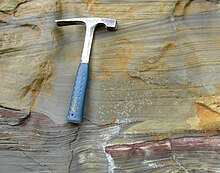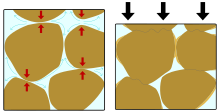Sediment transport and deposition
Cross-bedding and scour in a fine sandstone; the Logan Formation (Mississippian) of Jackson County, Ohio
Transformation (Diagenesis)
Pressure solution at work in a clastic rock.
While material dissolves at places where grains are in contact, that
material may recrystallize from the solution and act as cement in open
pore spaces. As a result, there is a net flow of material from areas
under high stress to those under low stress, producing a sedimentary
rock becomes more compact and harder. Loose sand can become sandstone in
this way.
Main article: diagenesis
The term diagenesis
is used to describe all the chemical, physical, and biological changes,
exclusive of surface weathering, undergone by a sediment after its
initial deposition. Some of those processes cause the sediment to consolidate into a compact, solid substance from the originally loose material. Young sedimentary rocks, especially those of Quaternary age (the most recent period of the geologic time scale) are often still unconsolidated. As sediment deposition builds up, the overburden (lithostatic) pressure rises, and a process known as lithification takes place.Sedimentary rocks are often saturated with seawater or groundwater, in which minerals can dissolve, or from which minerals can precipitate. Precipitating minerals reduce the pore space in a rock, a process called cementation. Due to the decrease in pore space, the original connate fluids are expelled. The precipitated minerals form a cement and make the rock more compact and competent. In this way, loose clasts in a sedimentary rock can become "glued" together.
When sedimentation continues, an older rock layer becomes buried deeper as a result. The lithostatic pressure in the rock increases due to the weight of the overlying sediment. This causes compaction, a process in which grains mechanically reorganize. Compaction is, for example, an important diagenetic process in clay, which can initially consist of 60% water. During compaction, this interstitial water is pressed out of pore spaces. Compaction can also be the result of dissolution of grains by pressure solution. The dissolved material precipitates again in open pore spaces, which means there is a net flow of material into the pores. However, in some cases, a certain mineral dissolves and does not precipitate again. This process, called leaching, increases pore space in the rock.
Some biochemical processes, like the activity of bacteria, can affect minerals in a rock and are therefore seen as part of diagenesis. Fungi and plants (by their roots) and various other organisms that live beneath the surface can also influence diagenesis.
Burial of rocks due to ongoing sedimentation leads to increased pressure and temperature, which stimulates certain chemical reactions. An example is the reactions by which organic material becomes lignite or coal. When temperature and pressure increase still further, the realm of diagenesis makes way for metamorphism, the process that forms metamorphic rock.


No comments:
Post a Comment